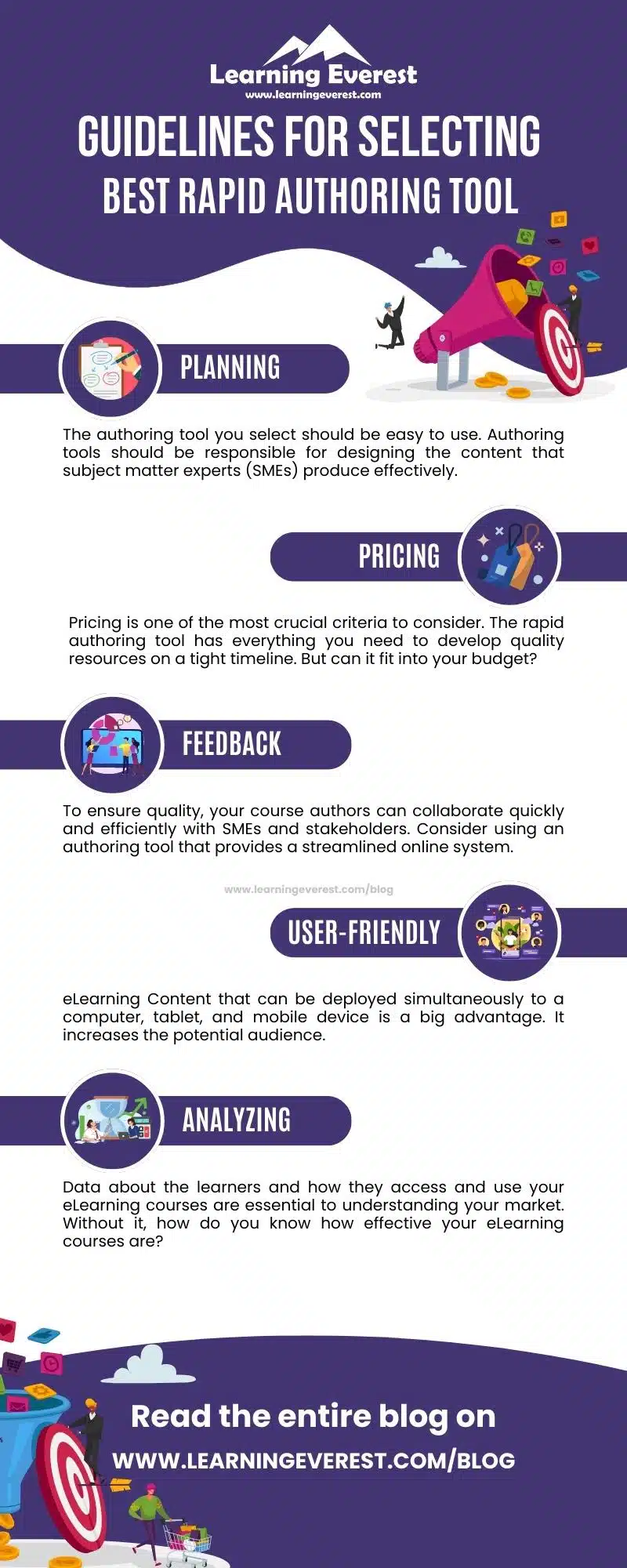Rapid eLearning Authoring tools provide the technical prowess to facilitate rapid eLearning development. Rapid authoring tools can reduce development time, making it easy to update existing courses (with source files), improve learner engagement, and publish LMS-compatible courses based on the latest technical standards (SCORM, xAPI, CMI5, etc.).
Table of Contents
- Here are some guidelines for selecting the best authoring tool for your organization
- Ease to use
- Check out the media libraries and assets in these tools
- Design flexibility and control
- Streamlined comment and feedback system
- Mobile learning-ready
- Easy publishing and maintenance (in the cloud)
- Check for translation ease
- Prebuilt pages and interactions
- Integrations/Easy export to LMS
- Analytics
- Pricing
- Infographics
Here are some guidelines for selecting the best authoring tool for your organization
Ease to use
The authoring tool you select should be easy to use. Authoring tools should be responsible for designing the content that subject matter experts (SMEs) produce effectively. You and your design team may compare the features and pick the best choice if you understand the benefits and downsides of various writing tools. If you discover that the tool does match your unique needs but are unsure of your designers’ proficiency with it, either engage a tool expert to assist you or contract out the course development to a vendor who is knowledgeable about utilizing that tool.
Check out the media libraries and assets in these tools
Before choosing a tool, consider the assessment templates provided by various means and the available alternatives for customized comments.
Design flexibility and control
Your brand is essential to you, so you will want much control over where your logo appears and the color palettes and fonts used in the courses. A high level of control is better, but if you have a lot of people developing courses, you do not want them to apply your standards in non-standard ways. Modern eLearning authoring tools address this by allowing you to design themes or templates that position and lock in certain on-screen components, including brand logos, background color schemes, and formatted text blocks. That leaves the eLearning course developers free to focus on dynamic elements, for example, text content, image interactions, and drag-and-drop components.
Streamlined comment and feedback system
To ensure quality, your course authors can collaborate quickly and efficiently with SMEs, reviewers, and stakeholders. Consider using an authoring tool that provides a streamlined online system. This allows reviewers to make comments or recommendations on the page they are reviewing. It means no more crossed or missed recommendations and duplicate or conflicting change requests. It reduces frustrations and delivers higher-quality content in less time.
Mobile learning-ready
eLearning Content that can be deployed simultaneously to a computer, tablet, and mobile device is a big advantage. It increases the potential audience by making it convenient for them to access the eLearning content from anywhere in multiple ways.
Easy publishing and maintenance (in the cloud)
You will inevitably need to change courses that you have published, either because the material updates or because you can find errors that must be corrected. When that happens, cloud-based rapid authoring tools are usually more effective and convenient than their desktop equivalents. That is because the source files for your courses and the eLearning authoring tool are held centrally and accessible to all your authors, wherever they are.
Check for translation ease
Choose an authoring tool to facilitate course translation with the least time and effort. Sometimes, it becomes necessary to translate the courses into various languages. You might want to get foreign clients, for example. In that case, it is a good idea to use an authoring tool with a built-in translation workflow.
Prebuilt pages and interactions
The best eLearning authoring tools assist you with the complexities of what they are doing. Yet, they allow you to incorporate powerful, engaging, interactive elements into your courses. For example, a prebuilt theme can contain dozens of interactions, like drag and drop, hotspots, text and graphics, and multiple-choice questions. Where appropriate, these page types give a simple mechanism to customize them (for example, to position hotspots, change images, or add an answer option to a multiple-choice question page). These simple-to-use prebuilt interactions are the building blocks you can use to create your highly interactive eLearning masterpiece in the shortest possible time.
Integrations/Easy export to LMS
Most authoring tools publish a SCORM or Tin Can (xAPI) package suitable for importing into any compliant LMS. The main motif of SCORM and xAPI standards is to allow eLearning content and tools from different providers to launch and track learner progress using a common set of protocols. It is essential that the authoring tool of your choice supports, at the very least, the SCORM standard and that you can export easily to HTML5 formats, if not to both Flash and HTML5 formats.
Analytics
Data about the learners and how they access and use your eLearning courses are essential to understanding your market. Without it, how do you know how effective your eLearning courses are? Good data can reveal a new potential market or indicate ways to serve current clients better.
Pricing
Lastly, pricing is one of the most crucial criteria to consider. The rapid authoring tool has everything you need to develop quality resources on a tight timeline. But can it fit into your eLearning budget? More importantly, is it worth the hype? You can determine if the software will meet your needs and improve your eLearning ROI.
Are you still wondering if a rapid authoring tool is really the best option? Read the article on Best Rapid Authoring Tool for eLearning to consider which rapid eLearning authoring tool is best for you. Some of the best rapid authoring tools are Articulate Storyline, Adobe Captivate, iSpring, Lactora.






